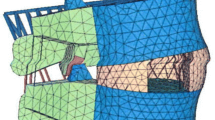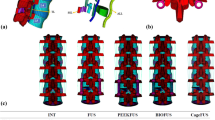Abstract
Objective
In recent years, Cage/SyCages or titanium mesh cages with interbody fusion have become a common surgical treatment for patients with cervical spondylosis and traumatic lesions. However, numerous complications have been reported, including hardware failure or breakage, which necessitate reoperation, and complications at the bone graft site. To improve upon the existing traditional titanium mesh cage, we designed a new pterygo-shaped titanium mesh cage (PTMC).
Methods
We designed a biomechanical study to assess the relative rigidity provided by the PTMC system using cadaveric cervical spine models. Early outcome assessments of patients undergoing anterior cervical decompression and stabilization with the described technique also were performed. Eight fresh human cadaver spine segments from C1 to C7 were loaded nondestructively with pure moments in a nonconstraining testing apparatus to induce flection, extension, lateral bending, and axial rotation, whereas angular motion was measured optoelectronically.
Results
The biomechanical results indicated that the PTMC provided effective stabilization for the unstable cervical segments in the eight cadavers (P < 0.01). Device displacement, prolapse, or collapse did not occur after surgery in any of the 27 adult patients that were followed postoperatively for 24–30 months (average 27.4 months).
Conclusions
The PTMC exhibited excellent biomechanical performance. It provided immediate stabilization and also avoided device displacement, prolapse, or collapse. Moreover, harvesting of iliac bone was not required.






Similar content being viewed by others
References
Bailey RW, Badgley CE (1960) Stabilization of the cervical spine by anterior fusion. Am J Orthop 42-A:565–594
Smith GW, Robinson RA (1958) The treatment of cervical spine disorders by anterior removal of the intervertebral disc and interbody fusion. J Bone Joint Surg (Am) 40:607–624
Cloward RB (1958) The anterior approach for removal of ruptured discs. J Neurosurg 15:602–617
Salcman M, Jamaris J, Leveque H et al (1979) Transoral cervical corpectomy with the aid of the microscope. Spine 4:209–212
Thalgou JS, Fritts K, Giuffre JM (1999) Anterior interbody fusion of the cervical spine with coralline hydroxyapatite. Spine 24:1295–1299
Samandouras G, Shafafy M, Hhamlyn PJ (2001) A new anterior cervical instrumentation system combining an intradiscal cage with an integrated plate: an early technical report. Spine 26:1188–1192
Epstein NE (2001) Reoperation rates for acute graft extrusion and pseudarthrosis after one-level anterior corpectomy and fusion with and without plate instrumentation: etiology and corrective management. Surg Neurol 56:73–80
Nakase H, Park YS, Kimura H et al (2006) Complications and long-term follow-up results in titanium mesh cage reconstruction after cervical corpectomy. J Spinal Disord Tech 19:353–357
Enneking WF, Eady JL, Burchardt H (1980) Autogenous cortical bone grafts in the reconstruction of segmental skeletal defects. J Bone Joint Surg Am 62:1039–1058
Akamaru T, Kawahara N, Sakamoto J et al (2005) The transmission of stress to grafted bone inside a titanium mesh cage Used in anterior column reconstruction after total spondylectomy: a finite-element analysis. Spine 30:2783–2787
Beaupe GS, Orr TE, Carter DR (1990) An approach for time-dependent bone modeling and remodeling-theoretical development. J Orthop Res 8:651–661
Beaupe GS, Orr TE, Carter DR (1990) An approach for time-dependent bone modeling and remodeling-application: a preliminary remodeling simulation. J Orthop Res 8:662–670
Chamay A, Tschantz P (1972) Mechanical influences in bone remodeling. Experimental research on Wolff’s law. J Biomech 5:173–180
Kenwright J, Richardson JB, Cunningham JL et al (1991) Axial movement and tibial fractures: a controlled randomized trial of treatment. J Bone Joint Surg Br 73:654–659
Weinans H, Huiskes R, Grootenboer HJ (1994) Effects of fit and bonding characteristics of femoral stems on adaptive bone remodeling. J Biomech Eng 116:393–400
Epstein NE (2000) The management of one-level anterior cervical corpectomy with fusion using Atlantis hybrid plate: preliminary experience. J Spinal Disord Tech 13:324–328
Bose B (2003) Anterior cervical arthrodesis using DOC dynamic stabilization implant for improvement in sagittal angulation and controlled settling. J Neurosurg 98:8–13
Lee SH, Sung JK (2008) Anterior cervical stabilization using a semi-constrained cervical plate and titanium mesh cage for single level corpectomy. J Clin Neurosci 15:1227–1234
Bagby GW (1998) Arthrodesis by the distraction-compress method using a stainless steel implant. Orthop 11:931–934
Tye GW, Graham RS, Broaddus WC et al (2002) Graft subsidence after instrument-assisted anterior cervical fusion. J Neurosurg 97:186–192
Gercek E, Arlet V, Delisle J et al (2003) Subsidence of stand-alone cervical cages in anterior interbody fusion: warning. Eur Spine J 12:513–516
van Jonbergen HP, Spruit M, Anderson PG et al (2005) Anterior cervical interbody fusion with a titanium box cage: early radiological assessment of fusion and subsidence. Spine J 5:645–649
Colpan ME, Attar A, Sekerci Z et al (2006) Cervical foraminal area and intervertebral height changes after titanium ring cage placement: preliminary results. J Clin Neurosci 13:228–232
Hakalo J, Pezowicz C, Wronski J et al (2008) Comparative biomechanical study of cervical spine stabilisation by cage alone, cage with plate, or plate-cage: a porcine model. J Orthop Surg 16:9–13
Acknowledgments
This work was supported by grants from the Foundation of the Hunan Provincial Health Department (No. B2007105). The new pterygo-shaped titanium mesh cage (PTMC) obtained a national patent certificate (No. 200620052134.9).
Conflicts of interest
None.
Author information
Authors and Affiliations
Corresponding author
Rights and permissions
About this article
Cite this article
Wang, Ls., Wang, Xj., Wang, Wj. et al. Design, biomechanical study, and clinical application of a new pterygo-shaped titanium mesh cage. Eur J Orthop Surg Traumatol 22, 111–117 (2012). https://doi.org/10.1007/s00590-011-0817-7
Received:
Accepted:
Published:
Issue Date:
DOI: https://doi.org/10.1007/s00590-011-0817-7




